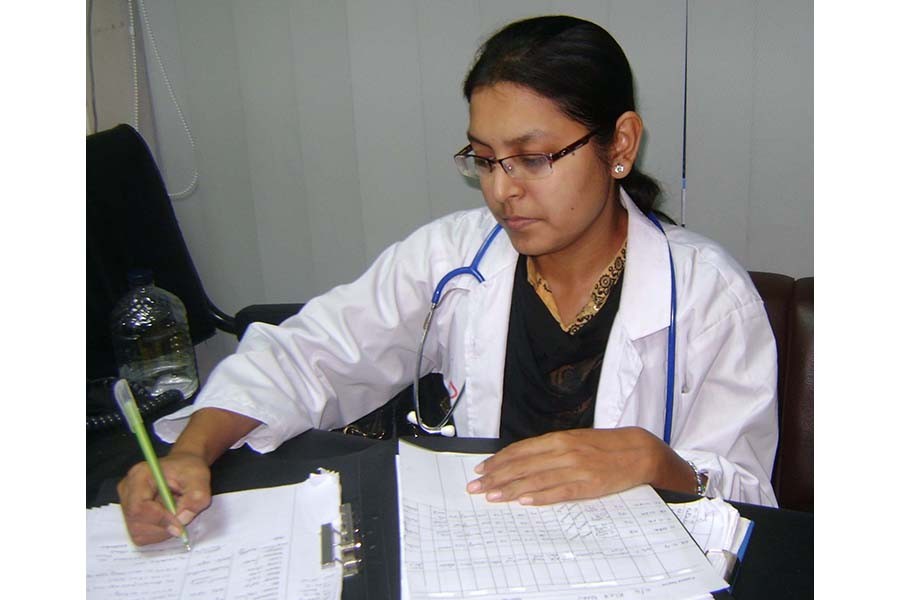Some years back the shortage of doctors, in terms of doctor-population ratio, was a matter of concern. But the situation has changed notably in recent years.
The ratio has improved and the number of physicians is now more than what the country needs, according to a recent study of the Bangladesh Bureau of Statistics (BBS), the state statistical organisation.
The BBS study said the number of doctors available in the country in 2016 was 74,924 as against the demand for 64,395, leaving a surplus of 11,529. The number of surplus doctors, according to an estimate, would be nearly 125,000 by 2026, if the current trend persists.
The scenario as far as availability of physicians is concerned should give rise to both satisfaction and concern.
All concerned have reasons to be satisfied because of the fact that the country now produces enough doctors to look after the physical well-being of the people. The situation even two decades back was dismal since the number of physicians was highly inadequate.
The worrying part of the latest development concerning the availability of doctors is that a large number of doctors are now unemployed and their number would grow every year.
A substantial number of doctors are engaged in private practice for the sake of their survival and, in this case also, more and more doctors would be forced to follow suit.
There is another side of the story. A good number of doctors, particularly those who have passed out from the little known private medical colleges, are now unemployed.
The employers both in private and public sectors do prefer medical graduates who attended government medical colleges. Their second choice obviously is the doctors who got their education in large private medical colleges having qualified teachers and adequate hospital facilities.
There is no denying that the establishment of a large number of private medical colleges is solely responsible for the production of doctors in excess of the demand. It is equally true that the country would have faced a serious shortage of doctors had there been no private medical colleges.
The decision to allow private medical colleges was timely one, no doubt. But the very purpose of having private medical colleges has largely been defeated to a great extent because the relevant authorities proved themselves to be extremely generous in granting permission to open such educational institutions. Political considerations, in many cases, influenced the process of granting permission.
Obviously, there has been negative fallout. Many sponsors being politically connected with the power-that-be did not feel it obligatory to go by the rules and fulfil all the requirements of operating a medical college.
According to a report published in a vernacular business daily, a 50-seat medical college is supposed to have an attached 250-bed hospital and, at least, 70 per cent of the beds would have to remain occupied all the time.
A number of private medical colleges neither have hospitals nor qualified teachers and modern medical equipment as per requirements. Thus, the quality of doctors that are being produced by this type of medical colleges is increasingly coming under scrutiny by the prospective employers.
The private medical colleges are producing more than 6000 doctors every year. Large and renowned private medical colleges are experiencing a rush of students while the opposite is happening to many little known medical colleges.
However, the private medical institutions have been charging fat fees from their students, for their sponsors are out to squeeze out as much as possible from the parents/guardians.
Most private medical colleges are thriving because their public sector counterparts do not have sufficient number of seats to accommodate thousands of students every year.
The craze of becoming a doctor or an engineer among a section of students is well known. Some parents do spend millions on getting their sons and daughters admitted to private medical colleges. They are completely unaware of the job market. The trend is, however, nothing different from most other disciplines. The system of education is not at all market-oriented. That is why the issue concerning the dearth of skilled manpower does come to the fore again and again.
Another interesting aspect is that when there is a glut of newly passed-out unemployed doctors, the rural people are not having sufficient number of doctors in their localities.
The government has been employing every year a good number of doctors in rural health facilities. But most of the newly appointed doctors skip their duties and try to secure transfers to major urban centres, including Dhaka.
The prospect of getting employment abroad by the Bangladeshi doctors is also not that bright. In fact, a very small number of doctors can secure employment abroad.
The quality of medical education is a major hurdle here. Medical education in Bangladesh is a shared responsibility of three authorities---the ministry of health, the Bangladesh Medical and Dental Council (BMDC) and the public universities, on regional basis.
But instead of so many authorities, the BMDC should have been the sole authority with adequate power and institutional capacity to manage medical education and the relevant institutions.


